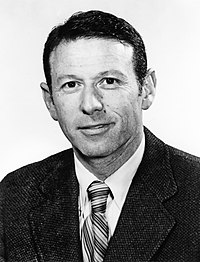
Photo from wikipedia
The world of human molecular genetics, virology and immunology has lost one of the pillars in the study of recombinant DNA technology and vaccine and genetic engineering with the passing… Click to show full abstract
The world of human molecular genetics, virology and immunology has lost one of the pillars in the study of recombinant DNA technology and vaccine and genetic engineering with the passing of Paul Berg. Inventor of one of the most powerful and trusted tools in the armamentarium of modern molecular biology, Paul Berg was the first biochemist-geneticist to incorporate DNA from the bacterium Escherichia coli into the potentially cancer-causing DNA polyoma tumor virus SV40, as was reported by his laboratory in late 1972 in the now classic paper in the Proceedings of the National Academy of Science United States (Jackson et al., 1972). Berg thereby created the first DNA molecule made from different parts of the genome of different organisms. This type of molecule became known as “hybrid DNA” or “recombinant DNA” with the idea to use the modified SV40 as a viral vector to carry “foreign” or “intelligent and strategically designed” genetic information into animal cells. Berg also discovered, and in part characterized transfer RNA (tRNA) and showed that amino acids needed to be activated before being attached to tRNA and before their assembly into proteins. Berg also was the first to purify the enzyme that carried out the formation of acetyl CoA, made deep inroads into our understanding of “activated acetate” and mechanisms related to fatty acid activation and polymerization and was the first to characterize the distribution of CpG dinucleotides in the human genome that distinguishes two distinct classes of eukaryotic gene promoters (Saxonov et al., 2006). Berg’s novel recombinant DNA discoveries are the basis for the biotechnology industry today worth hundreds of billions of dollars, that involve technologies capable of the editing of heritable genes in humans and the genetic engineering of new therapeutic treatments for many diseases and of vaccines, like the OPEN ACCESS
Journal Title: Frontiers in Cell and Developmental Biology
Year Published: 2023
Link to full text (if available)
Share on Social Media: Sign Up to like & get
recommendations!